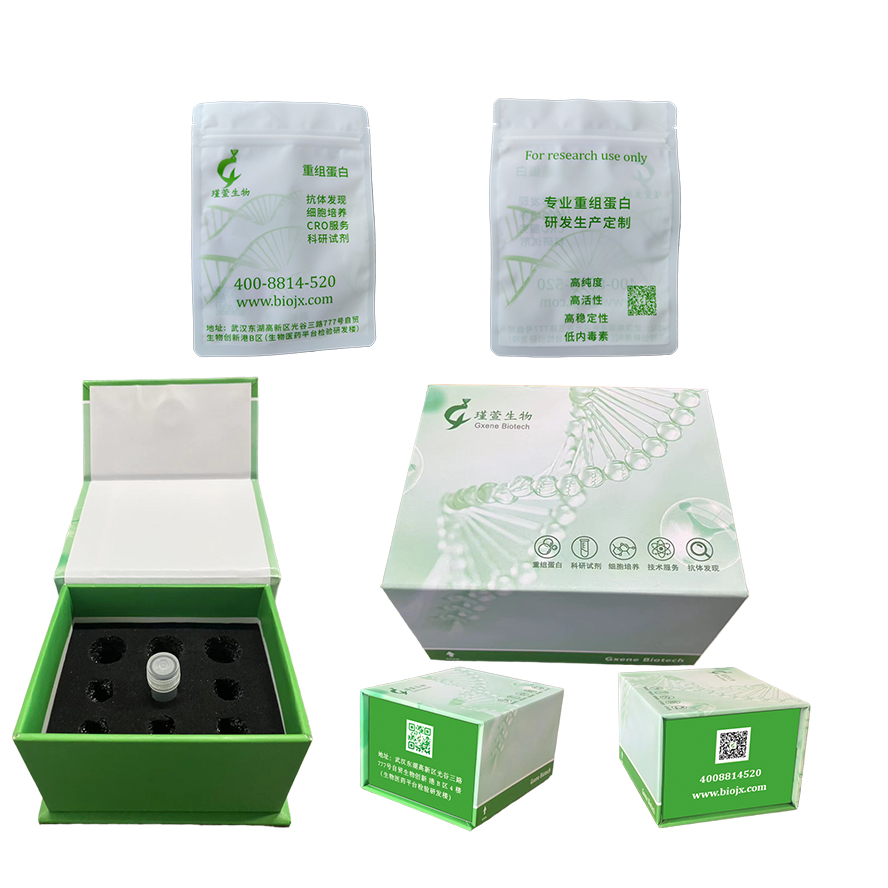描述
Recombinant Human FGFR-2/KGFR/CD332 Protein is produced by HEK293 cells expression system. The target protein is expressed with sequence (Arg22-Glu377) of human FGFR-2 (Accession #NP_000132.3) fused with a Fc, 6×His tag at the C-terminus.
内毒素
< 0.1 EU/μg of the protein by LAL method.
生物活性
1.Measured by its binding ability in a functional ELISA. Immobilized Recombinant Human FGF1 at 5 μg/mL (100 μL/well) can bind Recombinant Human FGFR2 with a linear range of 0.8-2.5 μg/mL.
2.Measured by its ability to inhibit FGF-acidic dependent proliferation of Balb/c 3T3 mouse fibroblasts. The ED50 for this effect is typically 0.256-0.991 ng/mL.
制剂
Lyophilized from a 0.22 μm filtered solution of PBS, pH 7.4.Contact us for customized product form or formulation.
储存
Store the lyophilized protein at -20°C to -80 °C for long term.
After reconstitution, the protein solution is stable at -20 °C for 3 months, at 2-8 °C for up to 1 week.未开盖的干粉蛋白在 -20°C至-80°C可保存12个月;
复溶之后,蛋白溶液在-20°C及以下可保存3个月,在2-8℃可保存1周。
复溶
Centrifuge the vial before opening. Reconstitute to a concentration of 0.1-0.5 mg/mL in sterile distilled water. Avoid votex or vigorously pipetting the protein. For long term storage, it is recommended to add a carrier protein or stablizer (e.g. 0.1% BSA, 5% HSA, 10% FBS or 5% Trehalose), and aliquot the reconstituted protein solution to minimize free-thaw cycles.收到重组蛋白产品之后请检查蛋白冻干粉末是否贴于瓶底,如果粉末浮起,开盖之前请先低温离心。将蛋白用说明书中指定的缓冲液复溶至0.1-0.5 mg/mL(请注意蛋白复溶浓度不能低于0.1 mg/mL),室温平衡5-10 min保证充分溶解,复溶过程中请不要剧烈涡旋及吹打蛋白溶液。如需长期储存,建议复溶时添加载体蛋白或者稳定剂(如0.1% BSA, 5% HSA, 10% FBS 或者 5% 海藻糖),同时将复溶后的蛋白溶液按照需求进行分装,储存于-20°C至-80°C,随取随用,避免反复冻融。
背景信息
The protein is a member of the fibroblast growth factor receptor family, where amino acid sequence is highly conserved between members and throughout evolution. FGFR family members differ from one another in their ligand affinities and tissue distribution. A full-length representative protein consists of an extracellular region, composed of three immunoglobulin-like domains, a single hydrophobic membrane-spanning segment and a cytoplasmic tyrosine kinase domain. The extracellular portion of the protein interacts with fibroblast growth factors, setting in motion a cascade of downstream signals, ultimately influencing mitogenesis and differentiation. This particular family member is a high-affinity receptor for acidic, basic and/or keratinocyte growth factor, depending on the isoform. Mutations in this gene are associated with Crouzon syndrome, Pfeiffer syndrome, Craniosynostosis, Apert syndrome, Jackson-Weiss syndrome, Beare-Stevenson cutis gyrata syndrome, Saethre-Chotzen syndrome, and syndromic craniosynostosis.
别名
BBDS;BEK;BFR-1;CD332;CEK3;CFD1;ECT1;JWS;K-SAM;KGFR;TK14;TK25;FGFR2


